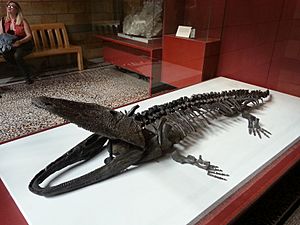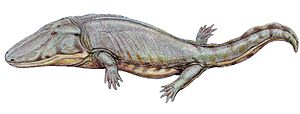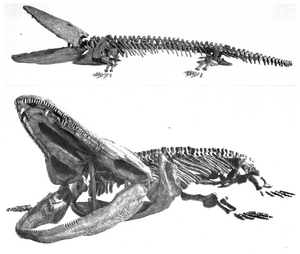Paracyclotosaurus facts for kids
Quick facts for kids Paracyclotosaurus |
|
|---|---|
 |
|
| Paracyclotosaurus davidi in the Natural History Museum of London | |
| Scientific classification |
|
| Kingdom: | Animalia |
| Phylum: | Chordata |
| Order: | †Temnospondyli |
| Suborder: | †Stereospondyli |
| Clade: | †Capitosauria |
| Family: | †Mastodonsauridae |
| Genus: | †Paracyclotosaurus Watson, 1958 |
| Species | |
|
|
Paracyclotosaurus (say "Para-sy-clo-toe-SAW-rus") means "Near Wheeled Lizard." It was a type of extinct amphibian called a temnospondyl. Imagine a giant salamander! This creature could grow up to 2.3 meters (about 7.5 feet) long.
Paracyclotosaurus lived during the Middle Triassic period, about 235 million years ago. Its fossils have been found in Australia, India, and South Africa. Even though it could move on land, Paracyclotosaurus likely spent most of its life in the water. It had a flat body and a long head, almost 60 centimeters (2 feet) long. Its head looked a bit like a modern crocodile's.
Contents
Discovering Paracyclotosaurus
The most famous type of this animal is P. davidi. We know about it from one complete fossil found in Australia. Quarry miners discovered it in 1910 in a brick pit in St. Peters, Sydney. The fossil was inside a large rock called an ironstone nodule. This nodule held a nearly complete skeleton.
Scientists finished putting the skeleton together in 1914. They first thought it was closely related to another ancient amphibian called Cyclotosaurus. The original bones of P. davidi were in poor condition. However, after carefully removing them from the hard rock, scientists made molds. These molds helped them create detailed casts of the bones.
Paracyclotosaurus davidii was named after Sir Edgeworth David. He helped the British Museum (Natural History) get the fossil specimen.
What Paracyclotosaurus Looked Like
The skeleton of Paracyclotosaurus davidii was found mostly together and complete. However, its skull and lower jaws were a bit squashed. The way its head connected to its backbone was hard to figure out. Some bones were also broken before the animal was buried.
The head of Paracyclotosaurus was about 60 cm (2 feet) long. At its widest point, the head was about 44 cm (1.4 feet) across. Its nostrils, eyes, and eardrums all pointed upwards. This suggests it might have spent a lot of time just below the water's surface.
The body of Paracyclotosaurus was quite wide. Its shoulders were about 53 cm (1.7 feet) across. When its front legs were resting, the total width between its middle fingers was about 87 cm (2.8 feet). The total length of the animal, including its tail, was around 225 cm (7.4 feet). Its tail was about 50 cm (1.6 feet) long and likely flattened. This flat tail probably helped it swim.
How Paracyclotosaurus Lived
Paracyclotosaurus could walk on land, but probably not very fast. Its tracks would have been about a yard wide. Each step would have been around 20 cm (8 inches) long. In water, it likely didn't leave many deep footprints. Its short tail might have helped it swim, but it probably wasn't very fast.
Paracyclotosaurus davidii had weak teeth. The teeth that could really bite into prey were on the roof of its mouth. These teeth were not much bigger than its other teeth. It's thought that this creature hunted like a modern Giant Salamander. It would wait quietly for prey to come close. Then, it would quickly open its huge mouth and swallow the prey whole.
Its main food was likely small fish, up to about 15 cm (6 inches) long. These fish often swam in groups. Scientists have found fossils of fish like Promecosomina buried with Paracyclotosaurus. This suggests these fish were a common meal.
Paracyclotosaurus probably waited for prey just below the water's surface. When a fish swam by, it would quickly lift its head. Its mouth would open wide, and the fish would be sucked inside. Modern predators, like crocodiles, use a similar hunting method.
How this animal breathed is not fully known. It might have breathed like the giant salamander genus Andrias. These salamanders move the floor of their mouth to pump air. Its skin was thick, so it probably didn't breathe much through its skin.
- Patricia Vickers-Rich and Thomas Hewett Rich 1993, Wildlife of Gondwana, ISBN: 0-7301-0315-3 Reed.
See also
 In Spanish: Paracyclotosaurus para niños
In Spanish: Paracyclotosaurus para niños





